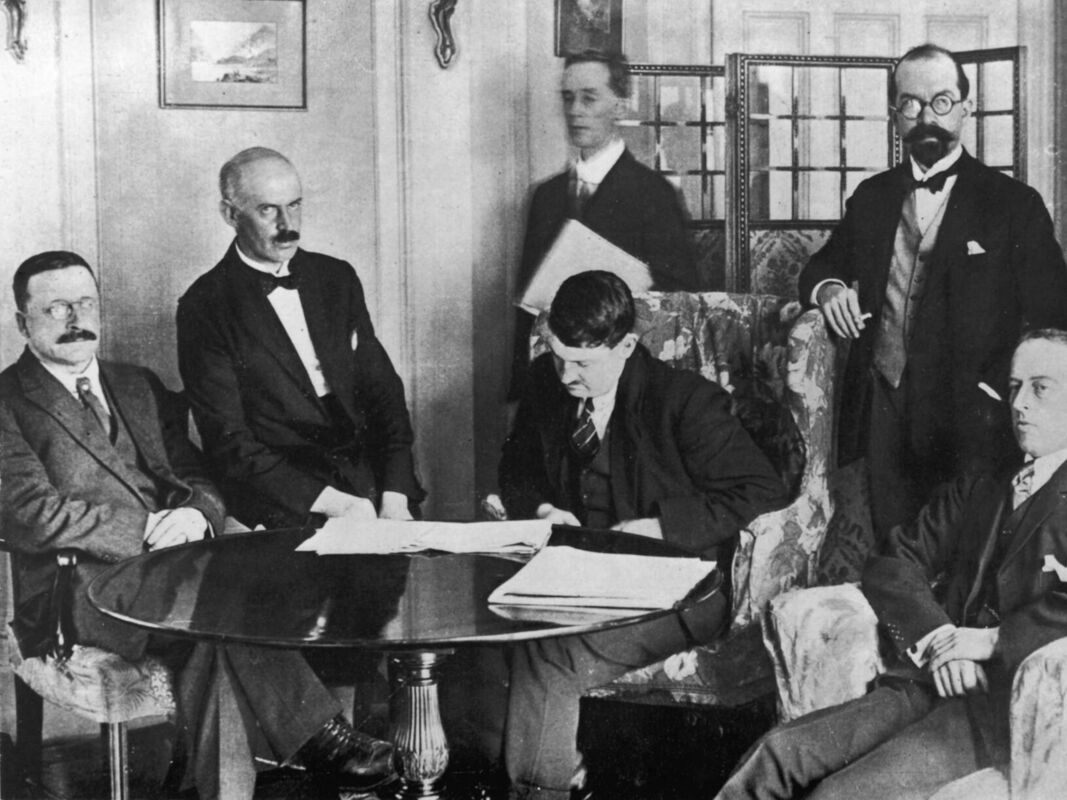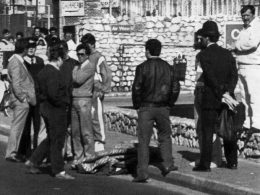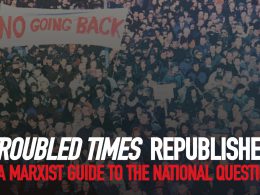By Manus Lenihan
On the night of 5-6 December 1921, five men piled into a taxi at Downing Street, London, and set off for their lodgings in a state of shock. The British Prime Minister, David Lloyd George, had just issued a dramatic threat. Five months of peace talks had suddenly narrowed to a take-it-or-leave-it choice with an arbitrary deadline: either sign the “peace treaty”, or face “war in three days.”
The five men were delegates from Dáil Éireann, the parliament set up by Sinn Féin MPs who won landslide elections in 1918 and 1921 but refused to take their seats in the UK parliament. They had been sent to London to negotiate a peace treaty after several years of guerrilla war between the British Army and the Irish Republican Army (IRA).
‘Hanged from lamp-posts’
Some of the Irish delegation at first refused to sign the treaty. But after agonising hours, they were worn down by threats and false promises from their fellow delegates. It was argued that if they signed, the partition of Ireland would be reversed. Meanwhile, anyone who refused to sign would be held responsible for starting a war, and ‘would be hanged from lamp-posts.’
Several times in those hours the delegates were ready to walk. But in the end they slunk back to Downing Street and signed the Treaty.
This was a key moment in the foundation of the southern Irish state. For the Irish ruling class, particularly for the Fine Gael political tradition, the signing of the Treaty is remembered as an act of statesman-like compromise and pragmatism. Many pro-imperialist historians of the revisionist tradition, who are closely connected with the thinking of Fine Gael, would also like to portray its outcome as an act of Irish people exercising their democratic right to self-determination, given that it won independence for a large part of the island. This ignores the fact that this was an agreement signed under duress in the face of threats from the largest imperial power in the world. It also ignores the fact that it helped copper-fasten partition, resulting the Catholic population of the North being imprisoned in a state in which they faced systemic discrimination and repression.
The Treaty was lauded as a ‘stepping-stone,’ a deal which made it possible to achieve true freedom in the future. But today we can look back from the vantage point of 100 years of ‘freedom’; on the mother and baby homes, the Magdalene Laundries and mass emigration. The organised workers’ movement was so powerful in the revolutionary period. Why was it thrown back so far afterwards? The same question can be asked about the role of women. So if the Treaty was a stepping-stone to freedom, why did it liquidate the aspirations of workers, women and youth, and hand power to ‘the most conservative-minded revolutionaries that ever put through a successful revolution’? (1)
The Irish Revolution — national & social
The struggle against British rule in Ireland involved the active participation of hundreds of thousands of ordinary people, especially workers and the poor. The anti-conscription general strike of 1918 was crucial. Boycotts of police and the British administration began that year in earnest. Strikes and civil disobedience campaigns spread. In 1919 there occurred the Belfast strike and the Limerick Soviet. April 1920 saw protests outside Mountjoy jail and hunger strikes on the inside, accompanied by a general strike of unprecedented scale that saw the establishment of Soviets.
The working class, poor and radical youth wanted to fight to the finish. The desire for national and social liberation was summed up in the idea of a ‘Workers’ Republic’.
But those in the leadership of the trade union movement had other ideas. They promised revolution in words while in practice de-escalating struggles and playing second or third fiddle to the Republican movement. For example, these were the words printed on the cover of the Voice of Labour on 2 March 1919:
Today the Soviet idea is sweeping westward over Europe […] The Soviet has shown itself the only instrument of liberation in Europe, the proletariat has shown itself the only honest and humane governing force in the world […] Again we say that Ireland’s best and most effective answer is the immediate establishment of Soviets, the instruments which will bring about the dictatorship of the Irish proletariat. (2)
But words were not matched by deeds. After calling off the Limerick Soviet the leaders of the movement agreed that it was ‘not the occasion’ for Revolution. This went hand in hand with the insistence by Sinn Féin leaders that ‘Labour must wait.’
Nationalism filled the void of leadership left wide open by labour. Over the course of 1919 the Irish Republican Army (IRA) guerrilla struggle developed into a full-scale guerrilla campaign. The Republican ‘gunman’ became a romantic figure. The masses were reduced to the role of bystanders, cheering on the guerrillas and from time to time helping them but not taking a direct part in the struggle.
Over 1920 and into 1921 the IRA’s armed struggle became the dominant factor in the south. Sinn Féin was now the undisputed leading political force.
Meanwhile, the Government of Ireland Act had partitioned Ireland. In the new autonomous state of Northern Ireland ultra-sectarian mobs organised to decapitate a developing labour movement and terrorise the Catholic minority. Expulsions from workplaces, particularly of trade union militants, kicked off two years of sectarian violence known as the ‘first Troubles.’
Already by late autumn 1920, we see the first peace overtures between the British government and the IRA. In other words, the IRA’s guerrilla strategy hit its limits quickly. The first half of 1921 saw the bloodiest phase of the war. The IRA was not broken but it was sorely tested.
Sinn Féin’s performance in the 1921 elections – another landslide – shored up the morale of the movement. But in mid-June, the IRA’s director of intelligence Michael Collins received a report from an informer that contained chilling news. The British army had contingency plans for all-out war in Ireland. Martial law and colonial government would be imposed all over the south; military reinforcements would pour in; all transport would be stopped. The IRA would not have a real answer to such measures. (3)
From Truce to Treaty
In July the IRA agreed to a truce with the British army so that a peace treaty could be negotiated. The whole country breathed a sigh of relief to be free from raids, ambushes, torture in police barracks, and all the grim features of the guerrilla struggle.
It was clear to the Sinn Féin and IRA leaderships that the war could not continue. Bar a few hardliners like Cathal Brugha, they were broadly in agreement on peace terms that would fall far short of a Republic. The bar was low. What happened over the next four or five months was that the delegates sent to London lowered the bar even further, past what many of their comrades were ready to accept.
The British politicians, with all the experience and self-confidence of the leaders of an empire, ran rings around the Irish delegates. It was a coalition government, and the Liberals used the Tories as a bogeyman. Lloyd George made false promises and bare-faced threats, and soon had Arthur Griffith in particular eating out of his hand.
The threat of ‘immediate and terrible war’ was not a false threat. But full-scale war was a dangerous and unpredictable course to pursue. The British empire was threatened by recent struggles in its other colonies (like India, Egypt and Nigeria) and in Britain itself trade unionists were in revolt. Army mutinies were a recent memory. Widespread sympathy for the Irish cause was part of a backlash against the militarism and propaganda of World War One.
The British ruling class would have given a considerable amount to avoid the risks of war. So in the negotiations, there were key elements that were still on the table: Ireland to be outside the British Empire though formally ‘associated’ with it; the source of sovereignty to be the people, not the Crown; Ireland to be neutral in foreign affairs and equal rather than subordinate to Britain.
Most importantly, there was the question of Northern Ireland. During the Treaty negotiations, ‘essential unity’ was still on the table – Northern Ireland as an autonomous area within Ireland. There was the possibility of each constituency in Northern Ireland holding a plebiscite (vote) to determine a new border. This might have been a fundamental challenge to partition. The questions of the Empire, the Crown, neutrality and equality were traded away in exchange for a false promise on Northern Ireland. The pro-treaty side were convinced that the British government’s promise of a Boundary Commission would result in the end of partition. In reality there was zero chance that a commission set up by the British state would actually prove to be a neutral arbiter.
But these hopes were not dashed until 1925 when the Boundary Commission’s report added insult to the injury that was partition. Not only did it propose only the most minimal changes, it proposed an exchange of territory in both directions! It was so shameful that both governments, north and south, agreed to suppress the report.
Treaty debates
After the signing of the Treaty, Sinn Féin and the IRA split into pro- and anti-treaty camps. Months of debate followed.
Neither side in the Treaty debates offered a way forward and practically nobody had anything to say about Northern Ireland or the labour movement. Both sides had led the Irish Revolution into a situation where a sell-out was inherent. The difference is that the pro-treaty side embraced this destiny and vented their fury on all who stood in their way. Meanwhile on the anti-treaty side there was a brave but doomed attempt to salvage the struggle for independence.
After the five Irish delegates put pen to paper, ‘public opinion’ – i.e. newspapers owned by rich people – engaged in unrestrained celebration. (4) The bishops were vocal backers of the treaty. Big businessmen and landowners too put their full weight behind it. It was clear that the wind was in the sails of the pro-treaty faction.
De Valera, President of Dáil Éireann, emerged as the anti-Treaty leader. His base of support was made up of shopkeepers, farmers’ sons and intellectuals, the layers which had given so much to the guerrilla struggle. Far from the common perception that De Valera was a divisive firebrand, he tried to bring the two sides together with the infamous ‘Document No. 2.’ This alternative treaty was intended to unite the two factions, but it was ridiculed because it was so similar to the Anglo-Irish Treaty.
The cabinet voted 4-3 in favour of the Treaty and, after fierce and dramatic debates, the Dáil voted in favour by narrow margins. The anti-Treaty TDs walked out in protest. Michael Collins told his departing opponents that they were: ‘Foreigners – Americans – English.’(5)
The ‘American’ was De Valera, who was born in New York to a Cuban father — ‘accusations’ that he was born outside of wedlock were aired during the Treaty debates. ‘English’ referred to Erskine Childers. Later that day Griffith declared that he would not listen to that ‘damned Englishman.’ The following year, during the Civil War, that ‘damned Englishman’ would face the Free State firing squad.
Those who opposed the treaty did not stake their lives on ‘Document No. 2.’ Rather the anti-treaty camp united all those who felt that the revolution had unfinished business. It is significant, for example, that all the women members of Dáil Éireann sided with the anti-treaty camp. The left-leaning Republicans – like Kathleen Lynn, Constance Markiewicz, Liam Mellows and Peadar O’Donnell – ended up in the anti-Treaty camp too, although many of their leaders were far more conservative.
All a bluff?
During the Treaty Debates the Longford guerrilla leader Seán Mac Eoin made a remarkable statement. His men were willing to fight – and any ‘who attempted to flinch my bullet crashes through their skull [sic].’ But, he insisted, they did not have the means to fight. ‘Whatever has been done, was done by bluff.’ (6)
So according to Mac Eoin, the IRA had been flying by the seat of its pants. The pro-treaty leaders had every reason to exaggerate, but even Mac Eoin’s blunt statement reflects a certain truth, which was that there was no prospect of a military victory.
But the strikes and protests of the revolutionary period were certainly not a bluff. What’s missing in a lot of commentary on the events of the period is an understanding that the real power lay not in a secretive paramilitary hierarchy but in the streets and the fields and the workplaces. As Conor Kostick wrote:
[…] without the willingness of hundreds of thousands of workers to boycott, strike, demonstrate and protest, the military activity of the 3000 or so IRA members who had managed to obtain guns would have proved insufficient. (7)
During the Treaty debates, the pro-treaty camp denigrated and minimised their own guerrilla campaign. But they ignored the key point, which was that the revolution was much broader than that guerrilla campaign.
Labour leadership fails
But these real foot-soldiers of the revolution – those who struck, boycotted and marched – did not have a voice in the Treaty debates. The labour leadership once again took a back seat. It was pro-treaty, though the Labour Party was officially neutral. A contemptible statement from the ITGWU paper sums up the position: ‘The Dáil and not Labour has been entrusted and invested by the Irish people with the authority and the responsibility. In that, the people may have done well or ill — it is for none of us to say now.’ (8)
Trade union branches were banned from debating the Treaty or passing resolutions on it. All those people who might have supported a labour campaign against the Treaty had a bitter choice: either to enter the confusion of the De Valera camp, or to be cast in the role of bystanders once again. The memoirs of the playwright Seán O’Casey record the reaction of trade unionists and political activists to the Treaty debates. The dominant mood is one of bewilderment. (9)
There were some forces in the labour movement that did clearly oppose the treaty. Jim Larkin denounced the treaty as a sell-out. He did so, however, from Sing Sing prison where he had been jailed for his anti-war and revolutionary activities in the U.S. When he was released in 1923 he correctly argued that the Treaty should be fought through strike action and mass mobilisations. However, he did so at a time when workers were exhausted and demoralised by the reality of the civil war and the counter-revolution.
Similarly, other revolutionary socialists opposed the treaty. The new Communist Party, formed by James Connolly’s son, Roddy Connolly, argued it would lead to “social hell” and alongside partition was the spearhead of the counter-revolution. However, this group was small and inexperienced and while it took initiatives to convince the anti-treaty side to adopt a radical programme, it largely acted as a cheerleader of anti-treaty forces who saw the key to winning as an armed campaign rather than fighting for a new revolutionary wave of strikes and mass protests.
What was the alternative?
The best argument for the Treaty, from a Republican point of view, was that it got rid of the British army and allowed an Irish military force to take over. Although a British military presence continued in the ‘Treaty ports,’ the removal of the British army from Ireland was very significant.
But the bitter reality was that the new Free State military was a tool of the Irish ruling class, and still subservient to Britain. The pro-Treaty IRA, who had been so fearful of fighting the British, were ready to fight a civil war with their former comrades, to repress the movement of local Soviets, to place rural areas under martial law in order to crush strikes, to fire at postal workers on a picket line, etc.
Platitudes to the effect that the Treaty represented compromise and ‘pragmatism’ ignore several important facts. First, the British government was threatening a bloody reign of terror. In the words of Liam Mellows, “it was the fear of the people, not the will of the people” that accepted the Treaty. This does not fit the picture of dignified statesman-like deal-making.
Second, the republican leadership had already agreed to a ‘pragmatic’ sell-out; the issue is that the Treaty went a lot further. Third, the guerrilla struggle had run its course but the revolution had not. Far from it. The Treaty was in fact a conscious act to liquidate the revolution. The wealthy wanted ‘law and order’ so as to put an end to all the strikes. The Treaty represented counter-revolution. The best elements of the anti-Treaty side embodied a desire to rage against the dying of the light. But they lacked a strategy.
We have previously written that the Treaty and British imperialism could have been challenged:
if the leaders of the nationalist movement or of the labour movement had tried to mobilise ordinary people themselves into the struggle (or if the mass of people themselves mobilised) against military rule, on the promise that national freedom would also mean an end to economic and social exploitation. Then British imperialism and capitalism could have been threatened. Mass movements and struggle of that kind against British imperialism and its military would have gotten even stronger support in Britain. (10)
The strikes and Soviets of the time point to the real possibility of this; the truce and treaty period saw some of the most impressive and far-reaching local strikes. A working-class movement could also have won the sympathy of Protestant trade unionists and challenged partition. As Peter Hadden pointed out, “The De Valeras, Griffiths etc., had no perspective for the mobilisation of the workers. Their prominence was one of the factors repelling Protestant workers in the North.” (12)
The reality of the Treaty was that it was not a ‘stepping-stone’ to anything for the workers’ movement, for women, or for those who longed for a more just society. It did not move the situation forward but rather marked the beginning of the end of the revolutionary period. The potential to win a socialist Ireland based on the empowerment of working people, linked to a struggle for socialism in Britain and indeed Europe was lost. There was no further move toward freedom, but decades of the bishops calling the shots while people left the country in their hundreds of thousands. Considering the radical politics which characterised the revolutionary period – first and foremost within the labour movement – this was a terrible failure, a catastrophe.
- Kevin O’Higgins, a key Irish government minister in the 1920s, quoted by Donal Fallon: https://www.rte.ie/culture/2018/0419/955655-national-treasures-the-story-of-the-irish-revolutionary-years/
- Irish Opinion: The Voice of Labour, March 2 1918, available in Dublin City Library Archives, Newspapers Collection, March 2nd 1919
- Hart, Peter. Mick: The Real Michael Collins, Macmillan, 2005, p 275
- Townsend, Charles. The Republic: The Fight for Irish Independence, 1918-1923, 2014, p 358
- Hart, p 339
- Hart, p 329
- Kostick, Conor. Revolution in Ireland: Popular Militancy 1917-1923, Cork University Press,
- Kostick, Conor, Revolution in Ireland, UCC Press, 1996, p 185
- O’Casey, Autobiography Volume 4: Inishfallen, Fare Thee Well, Pan London 1949 (1972), p 86-89
- McLoughlin, Kevin. ‘The War of Independence, the Working Class and the Struggle for Socialism.’ https://socialistparty.ie/2019/01/war-of-independence-cententary-the-struggle-for-national-social-liberation/.
- Hadden, Peter. Divide and Rule, 1980. ‘1914-1921: Socialism or division.’ https://www.marxists.org/history/etol/writers/hadden/1980/divrule/ch2.html
Over the next few months we will release articles on the Irish Civil War and other topics related to the decade of centenaries.












